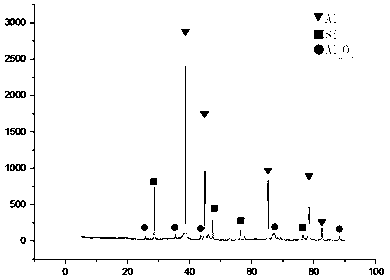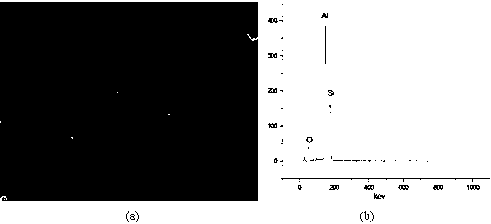Preparation method of aluminum-based composite material with low thermal expansion coefficient
A technology of aluminum-based composite materials and low thermal expansion coefficient, which is applied in the field of in-situ reaction preparation/Al composite material preparation and low thermal expansion coefficient aluminum-based composite materials, can solve the problems of high cost and complicated process, Achieve uniform distribution, good wettability and low thermal expansion coefficient
- Summary
- Abstract
- Description
- Claims
- Application Information
AI Technical Summary
Problems solved by technology
Method used
Image
Examples
example 1
[0033] Example 1 Al-SiO 2 Phases of composite materials prepared by system in situ reaction
[0034] Al powder and SiO 2 The powder is mixed evenly according to the mass ratio of 2.3:1, and then the powder is put into the ball mill for ball milling. The uniform powder is pressed under a pressure of 30MPa. Before pressing, apply anhydrous alcohol to the inside of the mold and the upper side of the pressure rod, and release the mold after holding the pressure for 6 minutes; sinter the pressed sample in a window-type vacuum furnace. , the sintering temperature is 700°C, the sintering time is 7h, the furnace is cooled after sintering, and the sintered sample is annealed at 450°C for 2.5h; figure 1 Shown is the XRD pattern of the sample sintered at 700°C. It can be seen that the mechanism reaction at this temperature is Al+SiO 2 →Al 2 o 3 +Si has been completely reacted, and the in-situ reaction of the material produces Al 2 o 3 phase and Si phase, which confirms...
example 2
[0035] Example 2 In-situ 42wt.% (Al 2 O 3 +Si) / Al aluminum matrix composite
[0036] Al powder and SiO 2 The powder is mixed evenly according to the mass ratio of 2.7:1, and then the powder is put into the ball mill for ball milling. Press under a pressure of 30MPa. Before pressing, apply water-based sodium stearate on the inner side of the mold and on the pressure rod, and release the mold after holding the pressure for 6 minutes; sinter the pressed sample in a window-type vacuum furnace for sintering. The temperature is 800°C, the sintering time is 7h, and the furnace is cooled after sintering; the sintered sample is annealed at 400°C for 3h; figure 2 a shows the low-magnification SEM image of the prepared composite material, it can be seen that the Al generated in situ by the material 2 o 3 Particles, evenly distributed and dense; figure 2 b shows the high-magnification SEM image, and the in-situ generated Si phase and Al can be seen 2 o 3The interface be...
example 3
[0037] Example 3 In-situ 42wt.% (Al 2 O 3 +Si) / Al aluminum matrix composite
[0038] Al powder and SiO 2 The powder is mixed evenly according to the mass ratio of 2.7:1, and then the powder is put into the ball mill for ball milling. Press under a pressure of 60MPa. Before pressing, smear anhydrous alcohol on the inner side of the mold and on the pressure rod, and release the mold after holding the pressure for 5 minutes; sinter the pressed sample in a window-type vacuum furnace for sintering, and the sintering temperature is 1000°C, the sintering time is 6h, and the furnace is cooled after sintering; the sintered sample is annealed at 500°C for 2h; image 3 Shown are the SEM image and EDS energy spectrum analysis image of the prepared composite material, from image 3 In a, it can be seen that the matrix of the samples obtained at higher sintering temperature is relatively dense compared with the composite material prepared at medium temperature, and compared wit...
PUM
| Property | Measurement | Unit |
|---|---|---|
| Thermal expansion coefficient | aaaaa | aaaaa |
Abstract
Description
Claims
Application Information
 Login to View More
Login to View More - Generate Ideas
- Intellectual Property
- Life Sciences
- Materials
- Tech Scout
- Unparalleled Data Quality
- Higher Quality Content
- 60% Fewer Hallucinations
Browse by: Latest US Patents, China's latest patents, Technical Efficacy Thesaurus, Application Domain, Technology Topic, Popular Technical Reports.
© 2025 PatSnap. All rights reserved.Legal|Privacy policy|Modern Slavery Act Transparency Statement|Sitemap|About US| Contact US: help@patsnap.com



